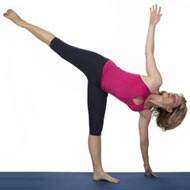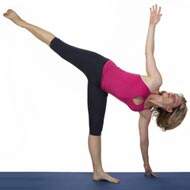- Ashtanga & Power Yoga
- Bikram Yoga
- Kundalini Yoga
- Vinyasa Yoga
- Hatha Yoga
- Jivamukti Yoga
- Karma Yoga
- Dahn Yoga
- Mantra Yoga
- Nada Yoga
- Patanjali Yoga
- Viniyoga
- Svaroopa Yoga
- Kali Ray Triyoga
- Ishta Yoga
- Integral Yoga
- Zen Yoga
- Kripalu Yoga
- Shakti Yoga
- Kriya Yoga
- Om Yoga
- Sivananda Yoga
- Ashtanga Yoga
- What is Karma?
- Power Yoga
Learning Yoga The Iyengar Way
1. What is Iyengar yoga?
Iyengar yoga can be described as a form of Hatha Yoga, in which the use of props is quite common. This discipline of yoga has been based on the traditional “eight limbs of yoga” concept as explained by Patanjali in the Yoga Sutras, over 2500 years ago.
Iyengar Yoga was created by Yogacharya Bellur Krishnamachar Sundararaja Iyengar (B.K.S. Iyengar), who trained people on his own style of yoga through the 20th century. He still not only practices Iyengar yoga every day, but also explores, studies, writes as well as teaches about it.
What makes Iyengar Yoga unique is that it is characterized by the use of asanas and pranayama, with emphasis on –
- Planned sequencing
- Precision in alignment
- Timing
- Use of props
Iyengar yoga is ideal for those individuals who are new to yoga and find it difficult to perform some of the more challenging asanas or postures. This yoga discipline adds props to the sessions, for increasing the ease of those who are practicing the poses. The props also help minimize the risks of strain or injury, making the poses a bit simpler for the young as well as the old.
Learners who are elderly, ill, injured or generally weak are advised to first take up Iyengar Yoga, as they can enjoy the benefits of various postures, while putting in less muscular effort. Some of the most commonly used props in Iyengar Yoga include –
- Belts
- Benches
- Blankets
- Chairs
- Cushions
- Foam blocks
- Mats
- Pillows
- Resistance bands
- Sandbags
- Straps
- Wooden blocks
Apart from the use of specific props, Iyengar Yoga also encourages active trainer correction in helping the participants discover poses intended to elevate their minds and bodies. Any error or misalignment while practicing the poses should be corrected by the trainer immediately. Iyengar yoga promotes more active correction as compared to most other forms of yoga. This is why it is more likely to help a wider range of participants to benefit from some of the ancient values of yoga.
There are several health benefits that people can enjoy with the regular practice of Iyengar yoga. However, it is important to consult a doctor before taking up any discipline in yoga.
2. Iyengar yoga poses
More than 200 classical yoga poses and 14 types of pranayama have been systemized by B.K.S. Iyengar in the development of Iyengar Yoga. These poses have been structured and categorized so that a beginner to the practice of yoga can progress safely from basic postures to the advanced ones. Iyengar yoga learners gain strength, flexibility and increased sensitivity in this process.
There are various sitting and standing yoga poses that could be a part of an Iyengar Yoga routine. In the beginning, these poses should not be held for more than 5 seconds. Some of the common Iyengar Yoga Poses include –
- Adho Mukha Svasana (The Downward Facing Dog Pose)
- Adho Mukha Virasana (The Downward Facing Hero Pose)
- Halasana (The Plough Pose)
- Padangusthasana (The Hand To Big Toe Pose)
- Parivritta Parsvakonasana (The Revolved Side Angle Pose)
- Parsvakonasana (The Extended Side Angle Pose)
- Paschimottasana (The Seated Forward Bend Pose)
- Salambha Sirsasana (The Headstand Pose)
- Sarvangasana (The Shoulder Stand)
- Savasana (The Corpse Pose)
- Supta Bandha Konasana (The Reclining Bound Ankle Pose)
- Swastikasana (The Ankle Lock Pose)
- Tadasana (The Mountain Pose)
- Trikonasana (The Triangle Pose)
- Uttanasana (The Standing Forward Bend Pose)
- Utthita Parsvakonasana (The Extended Side Angle Pose)
- Virasana I, II & III (The Warrior Pose I, II & III)
All beginners to yoga need to ensure that they learn the Iyengar Yoga poses from a certified and experienced yoga instructor. It is also essential to practice all the poses under the guidance and supervision of the trainer, at least in the beginning, to reduce the risks of injuries.
3. Iyengar yoga benefits
Iyegar yoga is an excellent practice for beginners to yoga as well as advanced yogis who are trying to work on their alignment. This discipline can offer all the health benefits of yoga, which include –
- Alleviating aches and pains, especially lower backaches
- Augmenting memory, focus, concentration and balance
- Decreasing stress, depression, anxiety and emotional problems
- Delaying the ageing process
- Enhancing posture
- Helping in weight loss
- Improving the circulation of blood and oxygen all over the body
- Increasing strength, stamina, immunity, awareness and flexibility
- Lowering the risks of heart diseases to a great extent
- Promoting better sleep, moods and appetite
- Reducing respiratory problems by improving the functioning of the respiratory system
The props used in Iyengar yoga could have additional benefits, which include –
- Aiding in faster recovery from an injury
- Applying a less amount of stress on the muscles
- Improving precision and alignment
Iyengar Yoga is one of the best forms of yoga for helping new learners with postures that are challenging. However, one of the downsides of Iyegar Yoga, according to some trainers, is that the diversified activity characteristic of this discipline can have a negative impact on some of the meditative aspects of yoga.
Though there are many health benefits that have been associated with Iyengar Yoga, it is important to check with a doctor before practicing it.



